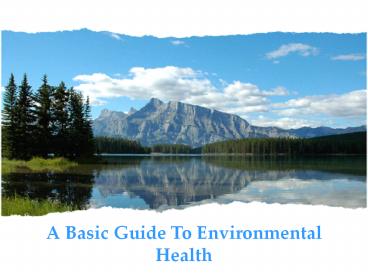A Basic Guide To Environmental Health - PowerPoint PPT Presentation
Title:
A Basic Guide To Environmental Health
Description:
Humans interact with the environment constantly. These interactions affect quality of life, years of healthy life lived, and health disparities. The World Health Organization (WHO) defines Environment, as it relates to health, as 'All the Physical, Chemical, And Biological Factors External to a Person, and all the Related Behaviors.' – PowerPoint PPT presentation
Number of Views:588
Title: A Basic Guide To Environmental Health
1
A Basic Guide To Environmental Health
2
Overview
- Humans interact with the environment constantly.
These interactions affect quality of life, years
of healthy life lived, and health disparities. - The World Health Organization (WHO) defines
Environment, as it relates to health, as 'All the
Physical, Chemical, And Biological Factors
External to a Person, and all the Related
Behaviors.' - Environmental Health consists of Preventing or
Controlling Disease, Injury, and Disability
related to the interactions between people and
their Environment.
3
- Creating health-promoting environments is complex
and relies on continuing research to understand
more fully the effects of exposure to
environmental hazards on peoples health.
4
Why Is Environmental Health Important?
- Maintaining a healthy environment is central to
increasing quality of life and years of healthy
life. Globally, nearly 25 percent of all deaths
and the total disease burden can be attributed to
environmental factors.
5
- Environmental factors are diverse and far
reaching. - They include
- Exposure to hazardous substances in the air,
water, soil, and food, - Natural and technological disasters,
- Physical hazards,
- Nutritional deficiencies,
- The built environment.
6
- Poor environmental quality has its greatest
impact on people whose health status is already
at risk. - Therefore, environmental health must address the
societal and environmental factors that increase
the likelihood of exposure and disease.
7
Understanding Environmental Health
- Environmental Health objectives focus on 6
Themes, each of which Highlights an Element of
Environmental Health Outdoor air quality, - Surface and ground water quality,
- Toxic substances and hazardous wastes,
- Homes and communities,
- Infrastructure and surveillance,
- Global environmental health.
8
- Outdoor Air Quality
- Poor air quality is linked to premature
death, cancer, and long-term damage to
respiratory and cardiovascular systems. Progress
has been made to reduce unhealthy air emissions,
but, in 2008, approximately 127 million people
lived in U.S. counties that exceeded national air
quality standards.Decreasing air pollution is an
important step in creating a healthy environment.
9
- Surface and Ground Water
- Surface and ground water quality applies to
both drinking water and recreational waters.
Contamination by infectious agents or chemicals
can cause mild to severe illness. Protecting
water sources and minimizing exposure to
contaminated water sources are important parts of
environmental health.
10
- Toxic Substances and Hazardous Wastes
- The health effects of toxic substances and
hazardous wastes are not yet fully understood.
Research to better understand how these exposures
may impact health is ongoing. Meanwhile, efforts
to reduce exposures continue. Reducing exposure
to toxic substances and hazardous wastes is
fundamental to environmental health.
11
- Homes and Communities
- People spend most of their time at home,
work, or school. Some of these environments may
expose people to - Indoor air pollution,
- Inadequate heating and sanitation,
- Structural problems,
- Electrical and fire hazards,
- Lead-based paint hazards.These hazards can
impact health and safety. Maintaining healthy
homes and communities is essential to
environmental health.
12
- Infrastructure and Surveillance
- Prevention of exposure to environmental
hazards relies on many partners, including State
and local health departments. Personnel,
surveillance systems, and education are important
resources for investigating and responding to
disease, monitoring for hazards, and educating
the public. Additional methods and greater
capacity to measure and respond to environmental
hazards are needed.
13
- Global Environmental Health
- Water quality is an important global
challenge. Diseases can be reduced by improving
water quality and sanitation and increasing
access to adequate water and sanitation
facilities.
14
Emerging Issues in Environmental Health
- Environmental health is a dynamic and evolving
field. - While not all complex environmental issues can be
predicted, some known emerging issues in the
field include
15
- Climate Change
- Climate change is projected to impact sea
level, patterns of infectious disease, air
quality, and the severity of natural disasters
such as floods, droughts, and storms
16
- Disaster Preparedness
- Preparedness for the environmental impact of
natural disasters as well as disasters of human
origin includes planning for human health needs
and the impact on public infrastructure, such as
water and roadways
17
- Nanotechnology
- The potential impact of nanotechnology is
significant and offers possible improvements to - Disease prevention, detection, and treatment,
- Electronics,
- Clean energy,
- Manufacturing,
- Environmental risk assessment.
18
weSRCH
www.wesrch.com
medical.wesrch.com































